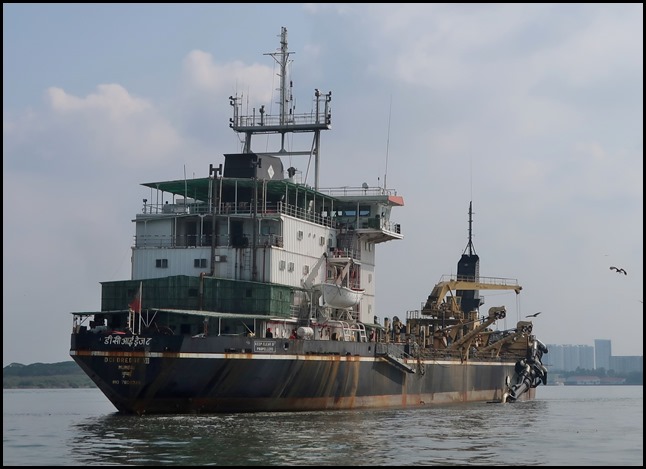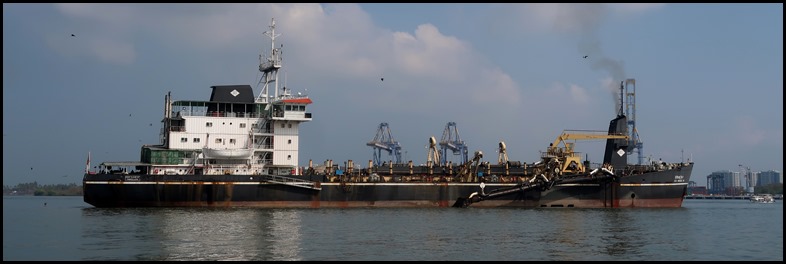To Kochi - Day 9

|
To Kochi - Day 9 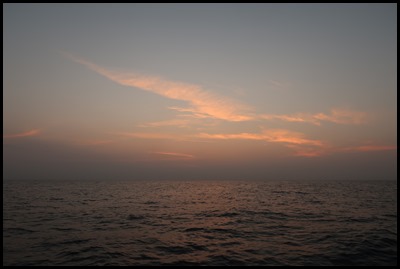 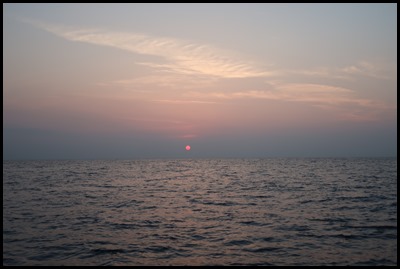 Friday the 5th of
April - Day Nine. I came on at six, are we there yet ??? very excited
as we are nearly there......... Views left and right. Bear topped our water tanks (water at the marine is not potable,
we had read) and then enjoyed his breakfast.
 A couple of hours
to go, the fairway in sight on the
chartplotter.
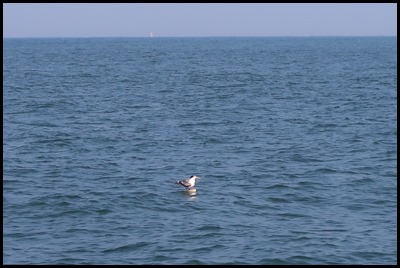 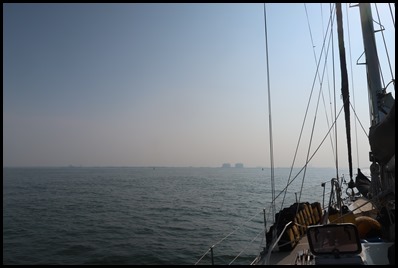 A little bird
resting on some rubbish. Land
ahoy.
 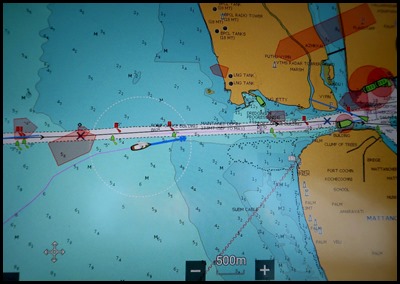 A helicopter
circled and went on his way. Now beside the
fairway.
 Big Buoys
lead the way.
     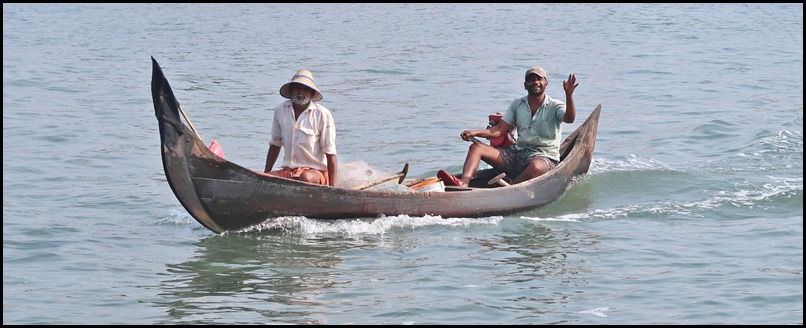 Lots to see and many waving enthusiastically in welcome.
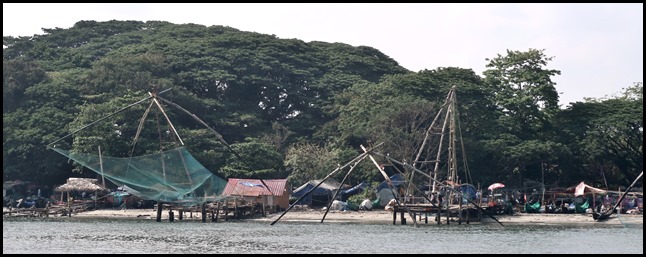 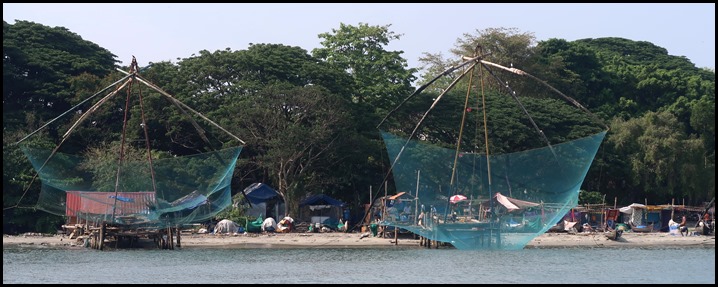 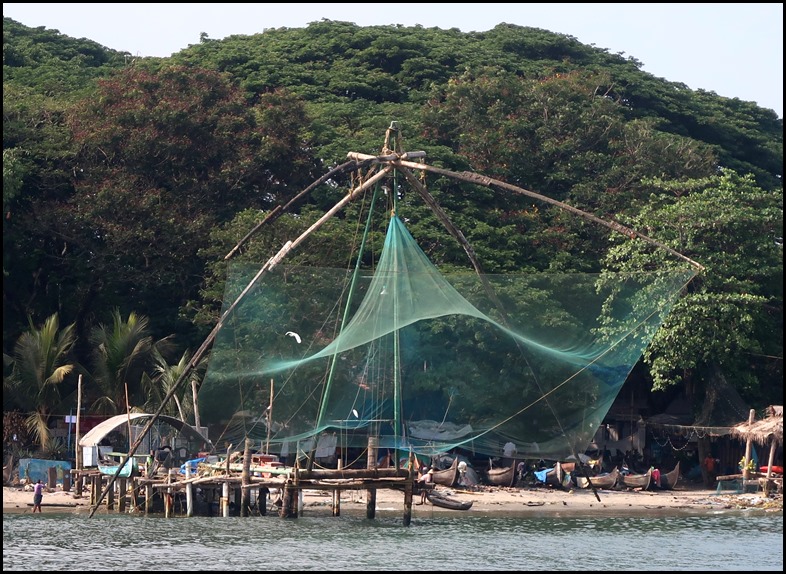 Each side of the entrance to the port
were fishing nets on wooden supports called Chinese
nets. We were lucky enough to watch one being pulled up but not as lucky
as the cheeky herons who swooped in for the steal......
 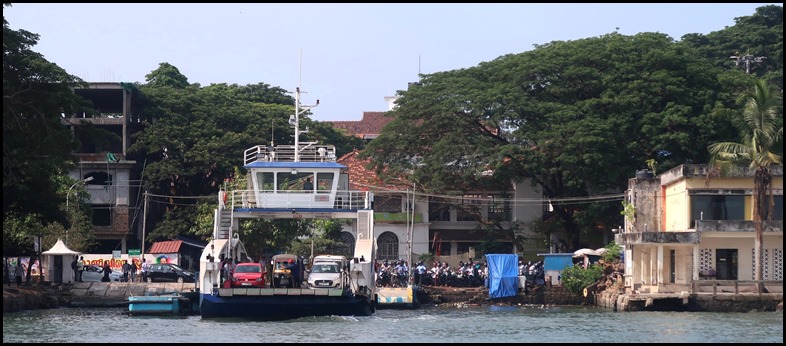 Car ferry
loading and ready to go.
 Aspinwall House is a large sea-facing heritage property in Fort Kochi on the way to Mattancherry. The property was originally the business premises of Aspinwall & Company Ltd. established in 1867 by English trader John H Aspinwall. Under the guidance of Aspinwall the Company traded in coconut oil, pepper, timber, lemon grass oil, ginger, turmeric, spices, hides and later in coir, coffee, tea and rubber.
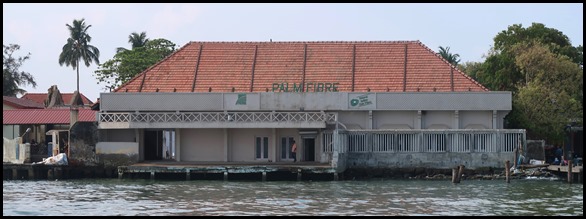
Next came a Palm
Fibre business, then...............
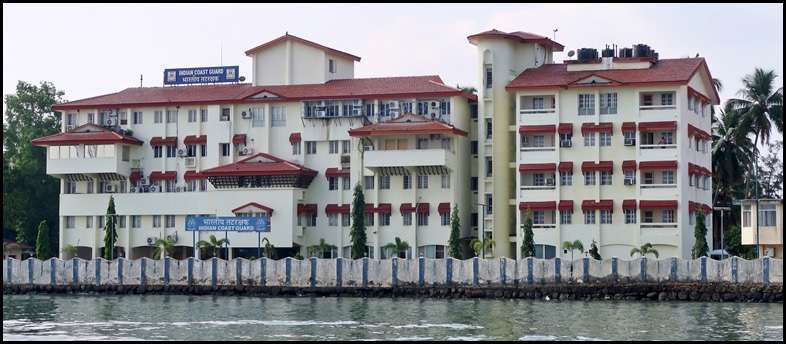 ........the large Indian Coast Guard building. The
ICG was formally established on the 18th of August 1978 by the Coast
Guard Act, 1978 of the Parliament of India as an independent armed force.
Employing over sixteen thousand personnel - using three pollution control
vessels, eighteen offshore patrol vessels, forty-two patrol vessels, sixty-eight
patrol boats, twenty-seven patrol craft and eighteen hovercraft and forty-four
aircraft.
 A bridge to our
left.
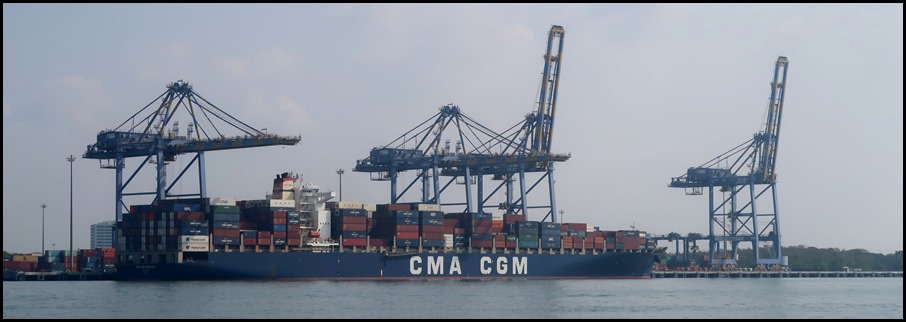 A chum in for loading. We found the following article and
added some of the girls we saw on our way to anchor by Port
Control.
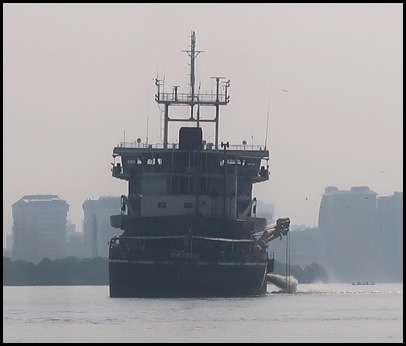 The Hindu (newspaper) dated Monday the
26th of May 2003 printed this piece:
This day, 75 years ago, the first ship sailed into the brand-new Cochin Port. C. Unnikrishnan narrates the daring story and the sheer guts of the hero of it all, Sir Robert Bristow.
"I live on a large Island made from the bottom of the sea. It is called Willingdon Island, after the present Viceroy of India. From the upper floor of my house, I look down on the finest harbour in the East". Thus, spoke Sir Robert Bristow proudly in his long address on the BBC on 11-8-1935. He was invited to speak in recognition of his successful endeavour that changed the course of an old port. Through a long saga of ambition, skill, determination and perseverance, he had created a modern port of Cochin, with the safest inner harbour. The first ship entered and berthed alongside the new harbour, exactly 75 years ago, this day, on 26-5-1928. Thus, the platinum jubilee of that glorious event falls today.
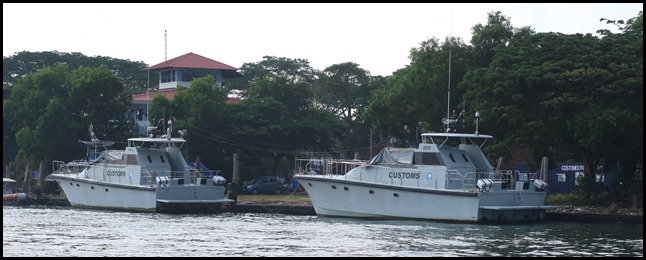
When Sir Bristow came to Cochin in 1920, it was a port where the ships were berthed offshore with cargo loading and unloading being done using lighters. The ships were exposed to all the violent forces of the open sea. Bristow was a visionary who foresaw that ports which would take ships alongside the berths only would have a future. When he left in 1941, he had transformed Cochin as the safest harbour in the peninsula, where ships berthed alongside the newly reclaimed inner harbour, equipped with a long array of steam cranes.

Since the early 1900's, there had been a demand for better facilities at the port from the trader fraternity. The Governor sought the services of an experienced harbour engineer from England. Sir Robert Bristow accepted the offer and proceeded to Cochin. After studying the sea currents, observing tidal conditions and conducting various experiments he was convinced about the feasibility of developing Cochin. He believed that Cochin could become the safest harbour if the ships entered the inner channel. The challenge before the Engineers who had studied the Port was a rock like sand bar that stood across the opening of the Cochin backwaters into the sea. It was a formidable ridge of heavy and densely packed sand that prevented the entry of all ships requiring more than eight or nine feet of water. It was thought that the removal of sand bar was a technical impossibility, that. the extent of the potential consequence on the environment was beyond estimation. The harm could be anything like the destruction of Vypeen foreshore or the destruction of the Vembanad lake.
Robert Bristow, after a detailed study, concluded that such data was history. He addressed the immediate problem of erosion of the Vypeen foreshore by building of rubble granite groynes nearly parallel with the shores and overlapping each other. The groynes first produced an automatic reclamation which naturally protected the shore from the monsoon seas. Confident at the initial success, Bristow planned out a detailed proposal of reclaiming part of the backwaters at a cost of Rs. 2.5 crores (equivalent to 250 Lakhs or 25 million Rupees). An ad-hoc committee appointed by the Madras government examined and approved the plans submitted by Robert Bristow. The construction of the dredger `Lord Willingdon' was completed in 1925. It arrived at Cochin in May 1926. It was estimated that the dredger had to be put to use for at least 20 hours a day for the next two years. So, the great work began demanding endless patience and perseverance. Hair breadth escapes for men and plant were regular. Bristow, relying largely on his judgement made immediate technical solutions. Bristow had always cared for the local sentiments and beliefs. He had now cut open a channel and created a reclamation that brought down the area of the lake. While the sand bar was cut he knew that the existing equilibrium of the local environment was being disturbed. He anticipated reactionary developments. He knew it would affect the Vypeen shore. He had been putting reinforcements on the Vypeen sea-walls so that the Vypeen foreshore would not be taken over by the sea. On the noon of March 30, 1928, he came to the sand bar or the last remains of it, that was to be removed by the dredger to make the sand bar a part of history. Robert Bristow, his engineers and staff gathered on the bridge of the dredger `Lord Willingdon' half an hour before noon on that day in March 1928, to be present during the last act of cutting through the sand bar. To celebrate the success, all the ships, tugs and barges assembled there ran up their flags and blew their hooters, until a phenomenon in the sky made a sudden stillness.

The sun, which had been hidden all morning, emerged from the clouds, and around it shone a perfect circular rainbow. Before the inner channel was declared ready for navigation, or was even properly marked with buoys, Capt. Bullen of the steam ship `Padma', coming down from Bombay on May 26, 1928, sailed calmly into the harbour against explicit signals from the Port officer. He proceeded to pick up every bale of cargo, which the Port could offer and which could be crammed into the vessel without sinking it. The modern Port of Cochin was opened to the world. According to the late Justice M.S. Menon, former Chief Justice of Kerala, and a close associate of Bristow, Sir. Robert enjoyed narrating a story which is easily identifiable with the philosophy of his life. Bristow used to say: "I love the reply of the French Minister to a queen of long ago: Madame, if it is only difficult, it is already done; if it is impossible, it shall be done.''
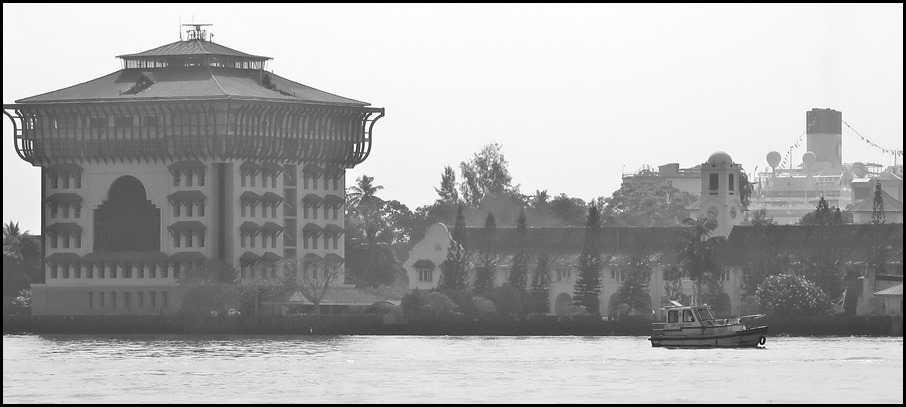 Anchored off the impressive Port Control building and a new friend.
 Harbour
Patrol for company............
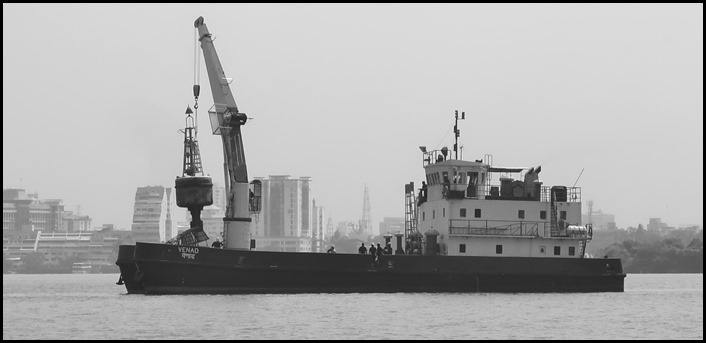 ............and buoy maintenance to watch.
ALL IN ALL RELIEF, HAPPINESS
AND GRATEFUL
HALF WAY ACROSS THE INDIAN OCEAN – BY HAND
!!!!!! |
